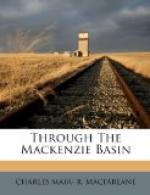At mid-day we reached Shoal Island—Pakwao Ministic—and here the poles were got out and the trackers took the middle of the river for nearly a mile, until deep water was reached. Placer miners had evidently been at work here, but with poor results, we were told. Below Baptiste Creek, however, the yield had been satisfactory, and several miners had made from $2.00 to $2.50 a day over their living expenses. Above the Baptiste there was nothing doing; indeed, we did not pass a single miner at work on the whole route, and it was the best time for their work. The gold is flocculent, its source as mysterious as that of the Saskatchewan, if the theory that the latter was washed out of the Selkirks before the upheaval of the Rockies is astray.
A fresh moose head, seen lying on the bank, indicated a hunting party, but no human life was seen aside from our own people. Indeed, the absence of life of any kind along the river, excepting the song-birds, which were in some places numerous, was surprising. No deer, no bears, not even a fox or a timber wolf made one’s fingers itch for the trigger. A few brent, which took wing afar off, and a high-flying duck or two, were the sole wildings observed, save a big humble-bee which droned around our boat for an instant, then darted off again. Even fish seemed to be anything but plentiful.
That night’s camp was hurriedly made in a hummocky fastness of pine and birch, where we found few comfortable bedding-places. In the morning we passed several ice-ledges along shore, the survivals of the severe winter, and, presently, met a canoe with two men from Peace River, crestfallen “Klondikers,” who had “struck it rich,” they said, with a laugh, and who reported good water. Next morning a very early start was made, and after some long, strong pulls, and a vigorous spurt, the mouth of the Lesser Slave River opened at last on our sight.
We had latterly passed along what appeared to be fertile soil, a sandy clay country, which improved to the west and south-west at every turn. It had an inviting look, and the “lie,” as well, of a region foreordained for settlement. It was irritating not to be able to explore the inner land, but our urgency was too great for that. From what we saw, however, it was easy to predict that thither would flow, in time, the stream of pioneer life and the bustle of attending enterprise and trade.
Chapter II
Lesser Slave River And Lesser Slave Lake.
It is unnecessary to inform the average reader that the Lesser Slave River connects the Lesser Slave Lake with the Athabasca; any atlas will satisfy him upon that point. But its peculiar colouring he will not find there, and it is this which gives the river its most distinctive character. Once seen, it is easy to account for the hue of the Athabasca below the Lesser Slave River; for the water of the latter, though of a pale yellow colour in a glass, is of a




